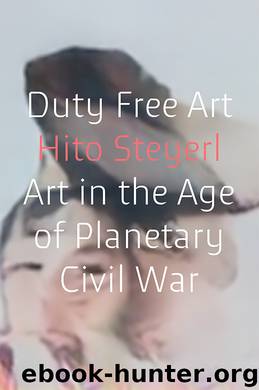Duty Free Art by Hito Steyerl

Author:Hito Steyerl
Language: eng
Format: epub, pdf
Publisher: Penguin Random House LLC (Publisher Services)
10
International Disco Latin
Let’s start with something else. Ever heard of the English Disco Lovers? A fantastic online project trying to outgun (or rather outlove) their acronym twin—the racist English Defence League, also abbreviated as “EDL”—on Facebook and Twitter. For this they use the bilingual slogan “Unus Mundas, Una Gens, Unus Disco (One World, One Race, One Disco).” The English Disco Lovers’ name is, of course, a deliberate misreading of the original, a successfully failed copy coming into being via translation.
Likewise in the case of many exhibition press releases—or so Alix Rule and David Levine claim in their widely read essay “International Art English.”1
International Art English, or “IAE,” is their name for the decisively amateurish English language used in contemporary art press releases. In order to investigate IAE, Rule and Levine undertake a statistical inquiry into a set of such texts distributed by e-flux.2 They conclude that the texts are written in a skewed English full of grandiose and empty jargon often carelessly ripped from mistranslations of continental philosophy.
So far so good. But what are they actually looking at? In the unstated hierarchies of publishing, press releases barely even make it to the bottom. They have the lifespan of a fruit fly and the farsightedness of a grocery list. Armies of these hastily aggregated, briefly circulated, poorly phrased missives constantly vie for attention in our clogged inboxes. Typically written by overworked and underpaid assistants and interns across the world, the press release’s pompous prose contrasts most acutely with the lowly status of its authors. Press releases are the art world’s equivalent of digital spam, vehicles for serial name-dropping and para-deconstructive waxing, in close competition with penis enlargement advertisements. And while they may well constitute the bulk of art writing, they are also its most destitute strata, both in form and in content. It is thus an interesting choice to focus on this as a sampling of art-speak, because it is not exactly representative. Meanwhile, authoritative high-end art writing is respectfully left to keep pontificating behind MIT Press paywalls.3
So what is the language used in the sample examined by Rule and Levine? As the authors incontrovertibly prove, it is incorrect English. This is shown by statistically comparing press releases against the British National Corpus (BNC), a database of British English usage. Unsurprisingly, this exposes the deviant nature of IAE, which derives, the authors argue, from copious foreign—mainly Latin—elements, leftovers from decades of mistranslated continental art theory. This creates a bastardized language that Rule and Levine compare to pornography: “We know it when we see it.” So, on the one hand, there is the BNC usage, or normal English. On the other, there is IAE, deviant and pornographic. Oh, and alienating too.
But who is it that is willingly writing porn here? According to Rule and Levine, IAE is, or might be, spoken by an anonymous art student in Skopje, at the Proyecto de Arte Contemporáneo de Murcia in Spain, by Tania Bruguera, and by interns at the Chinese Ministry of Culture.4
At this point
Download
This site does not store any files on its server. We only index and link to content provided by other sites. Please contact the content providers to delete copyright contents if any and email us, we'll remove relevant links or contents immediately.
The Secret History by Donna Tartt(18225)
Red Sparrow by Jason Matthews(5204)
Harry Potter 02 & The Chamber Of Secrets (Illustrated) by J.K. Rowling(3559)
In a Sunburned Country by Bill Bryson(3376)
Drawing Cutting Edge Anatomy by Christopher Hart(3301)
Figure Drawing for Artists by Steve Huston(3277)
Harry Potter and the Prisoner of Azkaban (Book 3) by J. K. Rowling(3125)
The Daily Stoic by Holiday Ryan & Hanselman Stephen(3116)
Japanese Design by Patricia J. Graham(3006)
The Roots of Romanticism (Second Edition) by Berlin Isaiah Hardy Henry Gray John(2824)
Make Comics Like the Pros by Greg Pak(2763)
Stacked Decks by The Rotenberg Collection(2699)
Harry Potter and the Deathly Hallows (7) by J.K. Rowling(2554)
Draw-A-Saurus by James Silvani(2514)
Tattoo Art by Doralba Picerno(2497)
On Photography by Susan Sontag(2494)
Foreign Devils on the Silk Road: The Search for the Lost Treasures of Central Asia by Peter Hopkirk(2389)
Churchill by Paul Johnson(2374)
The Daily Stoic by Ryan Holiday & Stephen Hanselman(2353)
